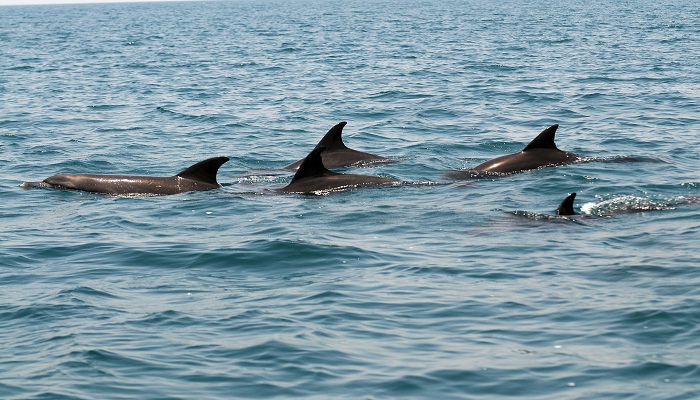
The Environment Agency – Abu Dhabi, EAD, through its ‘Dolphin Survey’, has estimated that 701 Indian Ocean humpback dolphins and 1,834 Indo-Pacific bottlenose dolphins inhabit Abu Dhabi’s coastal waters, with the Indian Ocean humpback dolphin population being the largest ever reported for this species in the world. The next largest population (466) is found in South Africa and other populations that have been estimated are typically very small; Mozambique (105), Kenya (104) and Tanzania (63).
Razan Khalifa Al Mubarak, EAD Secretary-General, said, ‘Dolphins are apex predators that bio-accumulate marine toxins, consequently, they are good indicators of marine environmental quality. As very little was known about the ecology and conservation status of dolphin species in Abu Dhabi waters, EAD started a dolphin survey in 2014. This has provided population size estimates and information on the main threats, which is required as a basis for the assessment, monitoring, and conservation of these charismatic species.’ To date, 64 days of vessel-based surveys have been completed covering 5,592 km of survey track. A total of 403 Indian Ocean humpback dolphins (Sousa plumbea), 693 Indo-Pacific bottlenose dolphins (Tursiops aduncus), and 52 finless porpoises (Neophocaena phocaenoides) were recorded. Population sizes were established using the ‘mark-recapture’ method, which relies on individual dolphins being identified, using the unique pattern of notches, cuts and nicks on the trailing edge of their dorsal fins.
Dr. Shaikha Al Dhaheri, Executive Director of the Terrestrial and Marine Biodiversity Sector of EAD, said, ‘We are very excited to have identified the presence of the world’s largest population of Indian Ocean humpback dolphins in Abu Dhabi’s waters. This further demonstrates the international value of Abu Dhabi’s marine biodiversity and it is our responsibility to ensure the conservation of this important resource. It also highlights the need of carrying out further research and monitoring activities in order to learn more about the ecology and habitat use of dolphins so that specific conservation measures can be implemented, and we are reaching out to corporate partners to support us in this.’ The results of the surveys demonstrated that the Indian Ocean humpback dolphin is a shallow-water species that occurs mostly in the channels and near-shore waters of the Abu Dhabi mainland and islands. The habitat of the Indo-Pacific bottlenose dolphin included both near-shore and deeper offshore waters. Finless porpoises have a narrow habitat preference, restricted distribution and are very rare.
Bruno Diaz Lopez, Chief biologist and Director of The Bottlenose Dolphin Research Institute (BDRI) in Spain, explained the international significance of the findings. ‘The discovery that Abu Dhabi has the largest population of Indian Ocean humpback dolphins has evoked scientific interest worldwide. It has also given Abu Dhabi an opportunity to become a global reference for the conservation of coastal dolphins. However, this opportunity may not last long. Abu Dhabi’s humpback dolphins are threatened by a variety of factors, some of which are plainly evident and others of which are poorly understood. Many of the dolphins bear evidence of serious injuries, at least some of which were caused by human activities. Without a doubt, future research studies and action is urgently needed to protect these vulnerable animals and their habitat.”

Post Your Comments